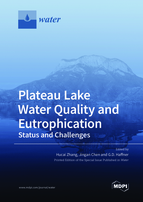Plateau Lake Water Quality and Eutrophication: Status and Challenges
A special issue of Water (ISSN 2073-4441). This special issue belongs to the section "Water Quality and Contamination".
Deadline for manuscript submissions: closed (30 November 2022) | Viewed by 34156
Special Issue Editors
Interests: lake sediments and environment change; paleoclimate and global changes; absolute dating (AMS-14C, OSL); lake ecology and water security; anthropology-paleontology and climate changes; stable isotopes and geochemistry
Special Issues, Collections and Topics in MDPI journals
Interests: water environment and security; lake eutrophication; sediment pollution and control; biogeochemical cycles of nutrients; isotope geochemistry
Special Issues, Collections and Topics in MDPI journals
Interests: aquatic ecology; developing models of energy/carbon and contaminant dynamics; speciation in Ancient lakes
Special Issue Information
Dear Colleagues,
Lakes, together with rivers and subterranean aquifers, are indispensable natural resources for humans and other organisms. Lakes not only play a crucial role in water supply, food production and climate regulation, they also function as a cornerstone for socio-economic susceptible development.
During the last century, anthropogenic climate changes, especially seasonal climate alternations, intensified widespread use of agricultural chemicals (e.g., fertilizers and pesticides), and rapidly increasing urbanization have dramatically changed regional watershed and hydrological patterns, exerting excessive pressure on lacustrine ecosystems.
Harmful algal blooms affect ecosystem productivity and public health globally and the costs are high. For example, during the last few years, the equivalent of tens of billions of US dollars have been allocated by the Chinese government to mitigate eutrophication of lakes. In Yunnan Province in southwestern China, conservation and pollution control of the so-called Nine Large Lakes (>30 km2) alone has cost more than 1.16 billion RMB Yuan (~180 million US dollars) during the last decade, but the situation is still serious.
It is necessary to consolidate a comprehensive understanding of the drivers of eutrophication on individual to regional clusters of lakes because lake status varies depending upon location, depth, area, agricultural and industrial intensity, and trophic status. This is our goal to organize this special issue published by the journal WATER, which has a global readership on the topic of eutrophication and water resource management.
Prof. Dr. Hucai Zhang
Prof. Dr. Jingan Chen
Prof. Dr. G.D. Haffner
Guest Editors
Manuscript Submission Information
Manuscripts should be submitted online at www.mdpi.com by registering and logging in to this website. Once you are registered, click here to go to the submission form. Manuscripts can be submitted until the deadline. All submissions that pass pre-check are peer-reviewed. Accepted papers will be published continuously in the journal (as soon as accepted) and will be listed together on the special issue website. Research articles, review articles as well as short communications are invited. For planned papers, a title and short abstract (about 100 words) can be sent to the Editorial Office for announcement on this website.
Submitted manuscripts should not have been published previously, nor be under consideration for publication elsewhere (except conference proceedings papers). All manuscripts are thoroughly refereed through a single-blind peer-review process. A guide for authors and other relevant information for submission of manuscripts is available on the Instructions for Authors page. Water is an international peer-reviewed open access semimonthly journal published by MDPI.
Please visit the Instructions for Authors page before submitting a manuscript. The Article Processing Charge (APC) for publication in this open access journal is 2600 CHF (Swiss Francs). Submitted papers should be well formatted and use good English. Authors may use MDPI's English editing service prior to publication or during author revisions.
Keywords
- eutrophication
- lakes and reservoirs
- water resource management
- water quality
- harmful algae
- sustainable devleopment
- multiple stressors








